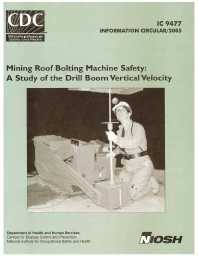Mining Publication: Mining Roof Bolting Machine Safety: A Study of the Drill Boom Vertical Velocity
Original creation date: May 2005
This report examines the boom arm vertical speed for roof bolting machines to study a moving boom arm appendage at different speeds during different work scenarios. The goal of this study is to determine the impact of the appendage speed on the likelihood of the operator's hand, arm, head, or leg making contact, such as touching the moving appendage. The overall research goal is to reduce workers' risks to injury from exposure to underground mining machinery. Accident investigation reports from the Mine Safety and Health Administration do not usually contain enough information to aid in studying this problem, and lab experiments with human subjects are not feasible because of safety issues. As an alternative, researchers used a unique computer simulation model that uses a virtual human, vision tracking, and generates random virtual human motions and risky work behaviors. By using specialized software to simulate the computer model, researchers accurately identified potential hazards of tasks where it is not possible to perform experiments with human subjects. Results of a frequency distribution analytic approach show that, regardless of other variables, contact incidents were always greater when the boom was moving up, always greater on the hand, and always greater for the boom arm part of the machine. The reason why the subject experiences more contacts when the boom arm is moving up rather than down is that more risky behaviors occur during drilling and bolting when the boom is ascending. Results of a cross-tabulation analytic approach show that the 25th- percentile operators experienced more contacts than other operator sizes and had most of their contacts during a boom speed of 13 in/sec. The hand-on-boom behavior during drilling and bolting tasks experienced more contacts than other work behaviors, and both tasks had most of their contacts during speed 13 in/sec. The 60-in seam experienced more contacts than other seam heights and had most of the contacts during speed 16 in/sec. For univariate logistic regression models, seam height is the most important predictor of the probability of a contact. However, a multivariate logistic regression model predicted contacts are more likely with the both-knee work posture in the 60-in seam, a 25th-percentile operator compared to a 55th-percentile operator, and speeds 16 and 22 in/sec compared to 7 in/sec. Results of a survival analytic approach suggest that controlling the boom speed is the most important factor in determining the risk of an operator making contact. Based on the data collected, boom speeds greater than 13 in/sec result in a substantial increase in risk to the roof bolter operator making contact. Speeds less than or equal to 13 in/sec are associated with a more modest relative risk of making contact, which represents a decrease in potential hazard. Virtual operator's response time has little effect on the number of contacts experienced. The mining industry can use the information in this study to reduce the likelihood that roof bolter operators will experience injury due to contact with a moving roof bolting machine's boom arm.
Authors: DH Ambrose, JR Bartels, AJ Kwitowski, RF Helinski, S Gallagher, LJ McWilliams, TR Battenhouse
Information Circular - May 2005
NIOSHTIC2 Number: 20026908
Pittsburgh, PA: U.S. Department of Health and Human Services, Public Health Service, Centers for Disease Control and Prevention, NIOSH, DHHS (NIOSH) Pub No. 2005-128, Information Circular 9477, 2005 May; :1-56
See Also
- Analyzing Factors Influencing Struck-by Accidents of a Moving Mining Machine by Using Motion Capture and DHM Simulations
- Analyzing Factors Influencing Struck-By Accidents of a Moving Mining Machine by Using Motion Capture and DHM Simulations
- Developing Random Virtual Human Motions and Risky Work Behaviors for Studying Anthropotechnical Systems
- Machine Injury Prediction by Simulation Using Human Models
- Mine Roof Bolting Machine Safety: Investigation of Roof Bolter Boom Swing Velocity
- Motion Editing and Reuse Techniques and Their Role in Studying Events Between a Machine and its Operator
- A PC-Based Monitoring System for Mine Hoisting
- A Simulation Approach Analyzing Random Motion Events Between a Machine and its Operator
- Upper Extremity Joint Moment and Force Predictions When Using a Joystick Control
- Verification and Validation of Roof Bolter Simulation Models for Studying Events Between a Machine and its Operator
- Content source: National Institute for Occupational Safety and Health, Mining Program


 ShareCompartir
ShareCompartir
